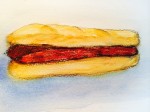 Most food in Argentina comes from somewhere else, at least in its earliest forms. Like wheat. Sure, there’s asado, an ubiquitous dish on Argentinian menus that is mostly a mound of barbequed meat. But in Argentina, the mishmash of culinary traditions that exists today reflects a long history of immigrants who left very little of anything that can be called truly Argentinian.
The view that the Argentinian national cuisine is actually a mix of British, Italian, and French food can be galling Read more [...]
Most food in Argentina comes from somewhere else, at least in its earliest forms. Like wheat. Sure, there’s asado, an ubiquitous dish on Argentinian menus that is mostly a mound of barbequed meat. But in Argentina, the mishmash of culinary traditions that exists today reflects a long history of immigrants who left very little of anything that can be called truly Argentinian.
The view that the Argentinian national cuisine is actually a mix of British, Italian, and French food can be galling Read more [...] The Pan in Choripàn
Reply
 Most food in Argentina comes from somewhere else, at least in its earliest forms. Like wheat. Sure, there’s asado, an ubiquitous dish on Argentinian menus that is mostly a mound of barbequed meat. But in Argentina, the mishmash of culinary traditions that exists today reflects a long history of immigrants who left very little of anything that can be called truly Argentinian.
The view that the Argentinian national cuisine is actually a mix of British, Italian, and French food can be galling Read more [...]
Most food in Argentina comes from somewhere else, at least in its earliest forms. Like wheat. Sure, there’s asado, an ubiquitous dish on Argentinian menus that is mostly a mound of barbequed meat. But in Argentina, the mishmash of culinary traditions that exists today reflects a long history of immigrants who left very little of anything that can be called truly Argentinian.
The view that the Argentinian national cuisine is actually a mix of British, Italian, and French food can be galling Read more [...] 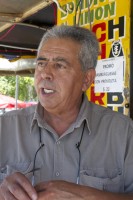 Pedro Molina’s white teeth reflect the Argentinian sun making a steady gaze into his eyes almost unbearable. For some reason, his smile reveals only his lower teeth, gleaming and even. Sitting in Buenos Aires under one of the umbrellas that shade the tables surrounding his stand, Pedro speaks with a low, soft voice as he describes his life as a vendor of choripán, a combination of chorizo and pane (bread), the two main ingredients of the classic Argentinian sandwich. Pedro flashes his bright smile
Pedro Molina’s white teeth reflect the Argentinian sun making a steady gaze into his eyes almost unbearable. For some reason, his smile reveals only his lower teeth, gleaming and even. Sitting in Buenos Aires under one of the umbrellas that shade the tables surrounding his stand, Pedro speaks with a low, soft voice as he describes his life as a vendor of choripán, a combination of chorizo and pane (bread), the two main ingredients of the classic Argentinian sandwich. Pedro flashes his bright smile 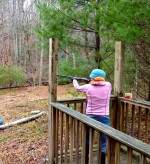 Can Food Be Too Local?
While shooting your own dinner is the sine qua non of localness, you should be allowed to draw the line. At Kelmscott Farm, I raised farm animals that met their death for the sake of high-end restaurants. This past weekend, I was shooting birds for sport, and yes, for food. But pulling the trigger put my meal just too close for comfort.
I joined a group of women who, judging from their gun bags and hunting attire, were experienced hunters. I, on the other hand, arrived
Can Food Be Too Local?
While shooting your own dinner is the sine qua non of localness, you should be allowed to draw the line. At Kelmscott Farm, I raised farm animals that met their death for the sake of high-end restaurants. This past weekend, I was shooting birds for sport, and yes, for food. But pulling the trigger put my meal just too close for comfort.
I joined a group of women who, judging from their gun bags and hunting attire, were experienced hunters. I, on the other hand, arrived  My last post about the early years of food on TV brought back memories of those days of easy pleasures created by the mere presence of a TV in your home. In our house, the small black and white television sat near the kitchen and afterschool we gathered round to watch Engineer Bill drink milk in between cartoons that he ran with his program, Cartoon Express.
William Stulla, AKA, Engineer Bill, began his program in 1954 and rolled into living rooms at 6:30 in Southern California, when I was six
My last post about the early years of food on TV brought back memories of those days of easy pleasures created by the mere presence of a TV in your home. In our house, the small black and white television sat near the kitchen and afterschool we gathered round to watch Engineer Bill drink milk in between cartoons that he ran with his program, Cartoon Express.
William Stulla, AKA, Engineer Bill, began his program in 1954 and rolled into living rooms at 6:30 in Southern California, when I was six 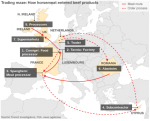 The daily revelations emerging from the discovery of horsemeat in lasagna purchased in Ireland reveal the complexities of our food system. When EU health commissioners tracked down the source of the horsemeat, they found a trail that passed through multiple countries, processors, dealers, brokers, Romania, England, Cyprus, Poland, the Netherlands, and in some cases, through illegal hands.
Since much of our meat is processed, ground up, blended with flavorings, shaped into meatballs and stuffed into
The daily revelations emerging from the discovery of horsemeat in lasagna purchased in Ireland reveal the complexities of our food system. When EU health commissioners tracked down the source of the horsemeat, they found a trail that passed through multiple countries, processors, dealers, brokers, Romania, England, Cyprus, Poland, the Netherlands, and in some cases, through illegal hands.
Since much of our meat is processed, ground up, blended with flavorings, shaped into meatballs and stuffed into 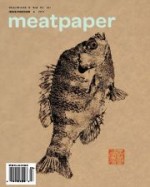 In November’s Meatpaper: Issue 19, you’ll find this essay, a short piece inspired by a trip I took with my dear friend, Linda.
Early Californians lusted after gold, traveling up and over the chiseled granite Sierra Nevada on their way to the Gold Country. Two summers ago, a dear friend and I had high prospects of climbing Mt. Whitney, repeating the trek we had previously taken over thirty years ago. We hove up and over the majestic peak before returning to our encampment at the base
In November’s Meatpaper: Issue 19, you’ll find this essay, a short piece inspired by a trip I took with my dear friend, Linda.
Early Californians lusted after gold, traveling up and over the chiseled granite Sierra Nevada on their way to the Gold Country. Two summers ago, a dear friend and I had high prospects of climbing Mt. Whitney, repeating the trek we had previously taken over thirty years ago. We hove up and over the majestic peak before returning to our encampment at the base  I've been working on a food-mapping project for the past several months called Food: An Atlas. The project is a non-profit venture launched by the CAGE (Cartography and GIS Education) Lab at the University of California at Berkeley. The project team intends to self-publish a map created by a network of content providers and cartographers over the web. The idea behind the project is to produce a food atlas in a short amount of time from a broad community of researchers. The Berkeley team, located
I've been working on a food-mapping project for the past several months called Food: An Atlas. The project is a non-profit venture launched by the CAGE (Cartography and GIS Education) Lab at the University of California at Berkeley. The project team intends to self-publish a map created by a network of content providers and cartographers over the web. The idea behind the project is to produce a food atlas in a short amount of time from a broad community of researchers. The Berkeley team, located